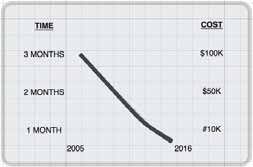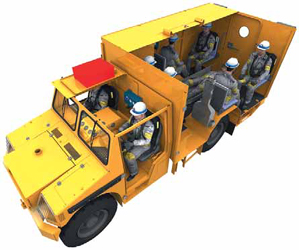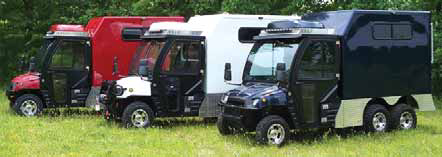
Computer-generated scenarios can provide mine
rescue teams with an ‘immersive’ learning experience
minus the risk of real-world hazards.
Lightening the Load
Studies and technologies focus on making mine rescue physically and mentally less stressful
By Russell A. Carter, Contributing Editor

There are plenty of opportunities for technological assistance in mine rescue preparation and practice. However, the importance of human performance in rescue missions has prompted a number of recent projects focusing on the need to understand the physical and psychological factors that come into play before, during and after rescue operations.
One of these studies measured the physical stress encountered by team members during strenuous rescue efforts. A presentation given at the International Mines Rescue Body Conference 2017, held in Moscow, Russia, detailed a Canadian project conducted by Laurentian University’s Center for Research in Occupational Safety and Health to understand the physiological demands, identify possible changes in operating procedures and policies, and reduce the risk profile of mine rescue operations — specifically, the risks to individual rescue team members in the field.* Members of mine rescue teams who participated in the study during the 2017 International Mine Rescue Competition were monitored for vital-sign information during identical simulated rescue activities that included multitask search and rescue under breathing apparatus and with exposure to adverse environmental conditions and situational stress.
The 27 five-man teams comprised a captain, vice-captain and three other team members, all of whom were fitted with monitoring devices to keep track of heart rate, heart rate variability, respiratory rate, skin temperature, core temperature, estimated VO2 Max (maximal oxygen uptake), and estimated energy expenditure as each team completed the same set of tasks in identical conditions and time constraints.
The results of these measurements confirmed that the physical demands of mine rescue are high for all positions but not equal, with the heart rate of certain participants approaching 190 bpm, core temperature of others rising above 39.5°C (103°F), and yet others reporting high respiration rates. The highest level of exertion was encountered during fire suppression and mine escape activities; the lowest was during casualty rescue. The researchers noted that combinations of these factors could very well result in a “heat event” affecting a team member during rescue exertions.
The study’s authors suggested that:
• All mining safety jurisdictions should
adopt a minimum fitness standard.
• Mine rescue policy and procedure
should limit team work to one to two arduous
tasks maximum before being relieved.
• Among the various team members, the
team captains experienced the lowest
level of physical demand during all of the
tasks. Because the captain/leader role in
all jurisdictions appears to require a lower
standard of fitness, the study pointed to
the possibility that older, less physically
fit mine rescue responders could be retained,
in an appropriate role, in order
to maintain operational experience.
Meanwhile, researchers at INSEMEX, a Romanian national institute that studies risk assessment and prevention in a number of resource-related industries, focused on the “mental strength” necessary to carry out mine rescue operations under stressful conditions, particularly if the level of stress is aggravated by other factors such as disrupted sleep patterns, family problems, illness or unrealistic expectations of performance. (It’s worth noting that in many rural areas in which mines are located, the customarily volunteer- force mine rescue teams are often first responders with other important roles, such as firefighters, for non-mining incidents as well.)
INSEMEX has developed a five-module training model with the objective of assisting mine rescuers in preparing for situations that may generate a need for psychological intervention to help them handle the negative impact of stress. The structure and objectives of the model were explained in a presentation also given at IMRB 2017.**
The individual modules include:
• Understanding the goals and role of psychological
training.
• Understanding and recognizing stress
symptoms.
• Identifying irrational thinking, and changing
possible negative patterns of thinking.
• Learning methods to prevent general
stress and manage traumatic stress.
• Identifying personality traits that play
a part in sanogenesis (psychological
“detoxification”).
The researchers recommend, based on results gained through development of the training model, that: 1) The main objective in coping with stress should be to prevent simple distress from degenerating into dysfunctional behaviors; 2) Coping with stress can be enhanced by developing a set of behavioral tools, starting with something as simple as relaxed breathing techniques.
xR Enables Risk-free
Rescue Practice
One of the most rapidly evolving methods
for exposing mine rescue team members
to potentially stressful situations — and
teaching them how to handle those situations
without risking actual physical
harm — is Virtual Reality (VR) simulation
training, along with its cousin technologies
Augmented and Mixed Reality, collectively
known as xR.

“For example, when doing a search, the system will monitor for breaches of LOS and provide a report at the end of the training session as to where and when the breaches occurred,” he explained. “As each of the training sessions are recorded for playback, any breaches of process and any other learnings can be discussed during the After Action Review. New recruits and experienced teams can learn from ‘best practice’ examples, which are readily replayed.
“Additionally, because the system can quickly load new scenarios, it allows brigadesmen the ability to have their skills rapidly and economically refreshed compared to traditional training methods, using significantly less resources,” he continued, pointing out that the service actually uses a blended approach, recognizing that virtual reality is not a panacea for training, but instead is a tool that complements regular practical training.
He also noted that the time and cost of developing the service’s scenarios has dropped dramatically over the past decade, as illustrated by the chart to the right. Another approach for reducing rescue- team stress is by preparing non-rescue personnel — fellow workers — to make informed decisions regarding initial medical assistance, safe escape and other concerns associated with emergency situations, thus taking a portion of the burden off rescue teams that may be racing to respond.
Instructional tools designed for this purpose range from software platforms to specific software apps, and combinations of apps, physical supplies and equipment. An example of a dedicated software platform comes from the Western Mine Safety and Health Training Center at the University of Arizona, which has developed MineSAFE, a platform for creating “serious games” for mine safety education. The objectives of the platform, according to the center, are threefold: (1) to elicit critical thinking about mine safety practices through interactive and contextualized learning; (2) to allow customization of learning materials for specific audiences, mine methods and sites; and (3) to empower trainers to evaluate user understanding and decision-making through a suite of integrated evaluation tools.
Using the MineSAFE platform, the center developed a variety of game prototypes addressing specific needs in mine safety training. One of them, titled “Harry’s Hard Choices,” focuses on mine emergency preparedness. Trainees role-play as a section foreman who must lead his crew to safety in the face of an unfolding mine disaster. The center stated that Harry’s Hard Choices provides an “exciting context” for learning that involves fires, lethal gases, explosions, injuries, failed equipment, ground falls and crew conflicts. An emergent storyline responds to players’ choices, forcing them to carefully consider each decision. Game mechanics, such as rewards and penalties, promote replayability as players strive to improve their scores and get better outcomes.
The Colorado School of Mines announced last year it incorporated the interactive Mobilize Rescue System into its Energy, Mining and Construction Industry Safety Program (EMCIS). The new technology is claimed to enable bystanders, even those without training, to manage medical emergencies such as severe bleeding, allergic reactions, cardiac arrest and more.
“We are trying to impart the idea that acting in the event of an injury improves the chances of a person surviving. Students retain far more information when they perform a hands-on activity rather than traditional didactic instruction. Incorporating Mobilize Rescue Systems into our training allows us to get students out of their seats and work the problem,” said Collin Smith, director of operations at the Colorado School of Mines’ EMCIS program.

The system includes instructions and supplies to manage severe bleeding, cardiac arrest, seizures, choking, chest trauma, hypothermia, burns, and more (around 80 medical emergencies) while rescuers are en route. Supplies in the Mobilize Rescue System kit are labeled and organized to match the instructions in the app (each item is color-coded and numbered).
Knowing Where to Go
A common principle in emergency medical
response is the “golden hour” — the
one hour or less following traumatic injury
during which there is the highest likelihood
that prompt medical treatment will
prevent death. In mine rescue situations,
a big chunk of that hour can be consumed
by logistical problems involved in locating
and reaching the scene of the incident.
However, there are software solutions and
equipment choices that offer potential
benefits for rescuers who need to pinpoint
incident locations and get there safely
and quickly. These range from dedicated
systems such as Innovative Wireless Technology’s
Mine Rescue product, which is
based on its Sentinel worker/asset tracking
system; to more comprehensive mine-data
and visualization products such as the Mobilaris
Mining Intelligence system.
IWT’s Mine Rescue solution uses the basic elements of the Sentinel tracking system, which includes a variety of handsets, handheld locators, vehicle-mounted comms units and other wireless technology to maintain location awareness to an accuracy of 200 ft. Working in collaboration with the U.S. Mine Safety and Health Administration (MSHA), IWT developed the rescue system primarily for coal mine applications, but said it also is applicable to hard rock and tunneling operations.
The Mobilaris Mining Intelligence system,
primarily developed to facilitate asset
identification and location as a means
to improve underground mining efficiency,
also has the capability to assist in expediting
mine rescue response. Described by
its developer as an intuitive real-time 3-D
visualization of every tunnel, vehicle, machine,
and person within and around the
mine, it also “enables an unprecedented
opportunity for mining personnel to make
the right decisions faster than ever at normal
operations as well as during emergency
situations,” according to the company,
which lists the main rescue-and-evacuation
capabilities of the program as:
• Able to transmit evacuation messages
to mine communications devices and
monitor in real-time who has received/
not received messages and who has acknowledged
them.
• Decision support that identifies individuals
requiring immediate attention (workers
that are either unaware of present
danger or are injured or trapped).
• Real-time directional guidance for rescue
personnel.
• Real-time monitoring of all refuge chambers.
• Control and status of event-related
messages.
• Managing evacuation according to defined procedures, and updating records in
the evacuation log when a process step is
accomplished, for post-event analysis.
Atlas Copco acquired 34% of Mobilaris MCE, the developer, in mid-2017. A number of major producers have implemented the system, including Barrick Gold, which recently installed it in the Hemlo mine in Canada. This follows earlier installations at the company’s Cortez Hills and Turquoise Ridge underground mines.
Once the location of an incident site is determined, getting there can take minutes or hours, depending on mine layout and the nature of the emergency — with lengthy travel time possibly using up critical on-site availability for rescuers using self-contained breathing apparatus (SCBA) en route. Mobile solutions are available, in the form of dedicated mine rescue vehicles and compact, rough-terrain ambulances, that enable rescuers to arrive as quickly as conditions permit, along with typical equipment needed for medical assistance and transport.

A mobile solution for rough-terrain emergency response is offered by the Med- Stat off-road ambulance, which is based on a Polaris Ranger 6 x 6 chassis and features a fully enclosed aluminum patient compartment large enough to accommodate a fullsize cot and seating for up to two attendants and a driver. The MedStat unit has three base models that can range from basic entry level up to fully configured versions. All models have an extensive list of options that gives the customer the flexibility to specify a MedStat unit that best fits their needs.
Under fully loaded conditions, the MedStat has been tilt-table tested to 24° and can climb slopes up to a maximum angle of 31°, while passing all braking tests, according to its manufacturer, Alternative Support Apparatus, based in Ohio, USA. External dimensions for the MedStat vehicle are 167 in. L x 93 in. H x 63 in. W (424 x 236 x 160 cm).
Breathing Easy
Often adding to the stress of rescuers faced
with locating, traveling to, and administering
aid to accident-scene casualties is the
necessity for using SCBAs, possibly for extended
periods and in conditions that can
generate a high level of physical stress even
without the need for external respiratory
support. SCBAs must be user-tolerable, extremely
reliable and uncomplicated, while
delivering the longest-lasting air supply possible.
It’s a tough design challenge, but one
for which “sweating the details” is absolutely
necessary for user comfort and confidence. SCBA suppliers such as Dräger, Biomarine
and MSA offer a variety of models to
meet wide-ranging requirements in various
industrial and public-safety applications.
Dräger’s BG4 regenerative SCBA is currently one of the most commonly used breathing apparatuses in the mine-rescue market. It incorporates features such as a four-hour air supply, ergonomically friendly carry plate and harness, and subtle positive- pressure airflow to prevent ingress by undesirable fumes or substances into the breathing circuit. The current BG4 Plus model also offers numerous product enhancements, according to the company.
Another popular closed circuit SCBA,
the Biopak 240 Revolution (240R) from
the Biomarine division of Neutronics,
features a long list of innovations designed
to improve the user experience
including faster deployment, easier
breathing effort and improved safety and
comfort. Reliability, according to the
company, was a top consideration in its
design approach, and consequently the
240R offers:
• A simpler alarming system — provides
at-a-glance recognition of system status.
• Lower part count.
• Protected breathing chamber — the system’s
rubber diaphragm is protected on
all sides by hard plastic, eliminating
risk of puncture or tearing should the
upper housing become dislodged.
• A proven pressure regulator — the BioPak
240R pressure regulator has more than
40 years of service in both CCSCBA and
SCUBA applications without a demonstrated
need for factory rebuilds or calibration
over its lifetime, according to
the company.